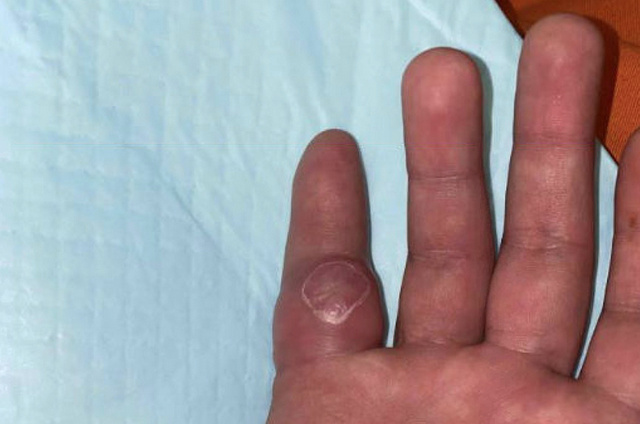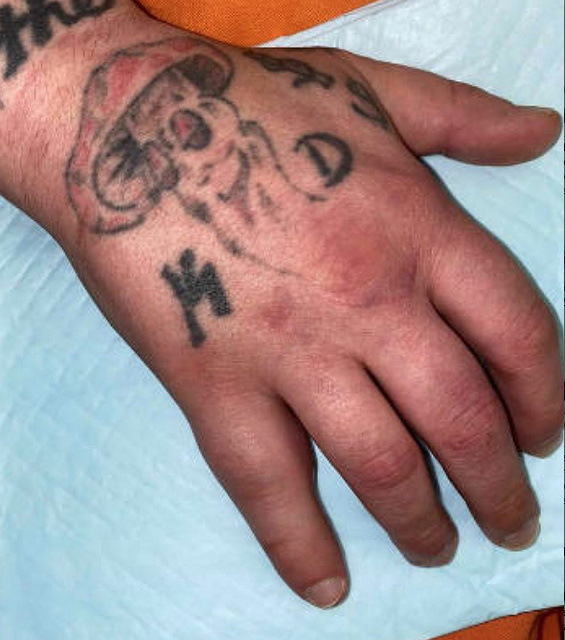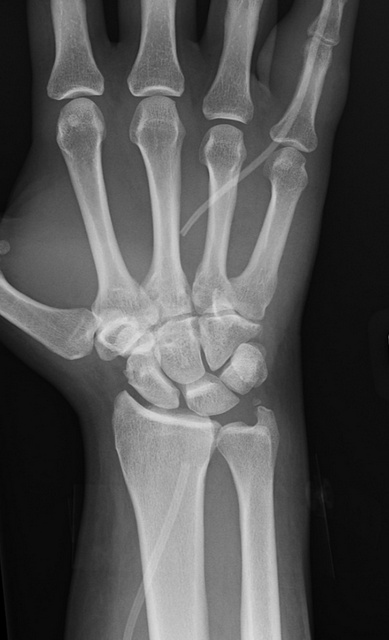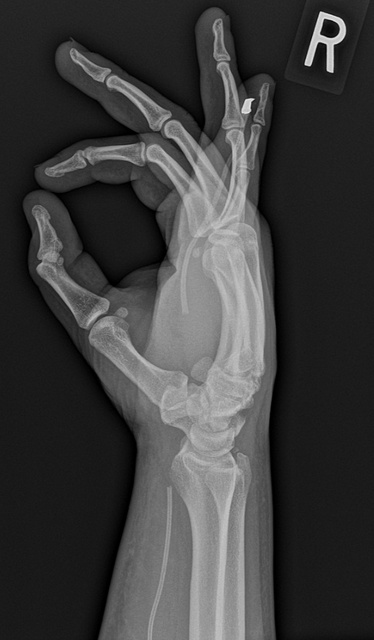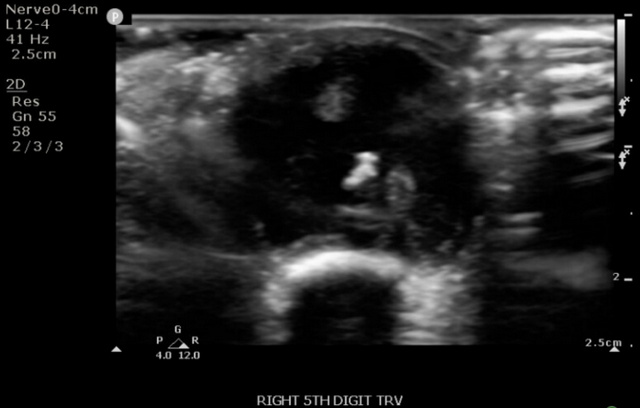This 34-year-old male presented to the emergency department with concerns for an infection involving his right hand. His past medical history was significant for bipolar disorder, bowel perforation, seizures, COVID-19, hepatitis and substance abuse.
He had a hunter rod placed 10 years ago for a staged flexor tendon repair s/p a flexor tendon rupture but was noncompliant with follow up. One year ago, he presented with increased pain and swelling of his pinky finger and reported that the hardware had failed and a screw had fallen out. Again, he was scheduled but did not follow up and was arrested before he could get the hardware removed. Over the past month he has been noticing increased pain and swelling to his hand and finger. He denied any fever, chills, or drainage and he had been taking clindamycin as prescribed for the past several weeks.
In the emergency department his vital signs were normal without any fever and he was moderate distress from pain. Examination of his right hand demonstrated a large amount of soft tissue swelling to the fifth finger and dorsum of the hand (figures 1a, b).
There was no drainage, warmth, or open wounds. He had FROM of the first thru fourth fingers. Sensation and pulses were intact. Motor strength in his wrist was 4/5 due to pain in the distal forearm. Multiple tattoos were present.
Labs showed: WBC 8.1 with no left shift, ESR 15, CRP 05, all within the normal range.
X-rays of the wrist and hand demonstrated no fracture or dislocation, stable appearance of a surgical device (an artificial tendon in the regions of the right flexor digitorum minimi tendon and flexor tendons of the right wrist), and a remote ulnar styloid fracture. There was fusiform soft tissue swelling of the proximal right fifth phalanx. There was some evidence of osteopenia but no evidence of osteomyelitis (figures 2a-b).
To determine if the swelling was cellulitis or an abscess, point-of-care (POCUS) was utilized and identified a large, complex, subcutaneous fluid collection surrounding the artificial tendon (figures 3a-b).
He underwent I&D of an abscess which revealed a large amount of purulent material. Cultures were sent and he was placed on cephalexin.
The patient was seen in Orthopedics three days after the ED visit and scheduled for surgery in one week.
Sulfamethoxazole/trimethoprim was added to the antibiotic regimen. However, prior to the surgery date, the patient returned to the emergency department for worsening pain and swelling. An I&D was performed, and he was started on oral doxycycline. Wound cultures from for ED visits were negative for pathologic bacterial growth.
The patient subsequently underwent successful surgery for hardware removal and had an uneventful post-operative course. He remained unable to flex the DIP and PIP joints.
Discussion:
Hunter rods are a temporary silicone implant designed to stabilize a damaged or severed tendon during the initial healing process, typically for several weeks or months. Complications of Hunter rods include buckling, migration and infection, which is uncommon. [1] There were no reports in the literature regarding infection rates for retained rods.
Several articles, include a recent meta-analysis have demonstrated that point-of-care ultrasound (POCUS) is a valuable adjunct for differentiating cellulitis from abscess with an overall sensitivity and specificity of 94.6% and 85.4% respectively.
Moreover, the authors found that POCUS led to a correct change in management in 10.3% of cases and an incorrect change in management in 0.7% of cases and that POCUS is particularly valuable in clinically unclear cases, where it significantly outperforms physical examination alone. [2,3]
References:
- Soucacos PN, Beris AE, Malizos KN, Xenakis T, Touliatos A, Soucacos PK. Two-stage treatment of flexor tendon ruptures. Silicon rod complications analyzed in 109 digits. Acta Orthop Scand Suppl. 1997 Oct;275:48-51. PMID: 9385266.
- Gottlieb M, Avila J, Chottiner M, Peksa GD.: Point-of-care ultrasonography for the diagnosis of skin and soft tissue abscesses: a systematic review and meta-analysis. Ann Emerg Med 2020; 76: pp. 67-77
- Gottlieb, M., Sundaram, T., Kim, D.J. et al. Just the facts: point-of-care ultrasound for skin and soft-tissue abscesses. Can J Emerg Med 23, 597–600 (2021). https://doi.org/10.1007/s43678-021-00132-9
- Soucacos PN, Beris AE, Malizos KN, Xenakis T, Touliatos A, Soucacos PK. Two-stage treatment of flexor tendon ruptures. Silicon rod complications analyzed in 109 digits. Acta Orthop Scand Suppl. 1997 Oct;275:48-51. PMID: 9385266.





